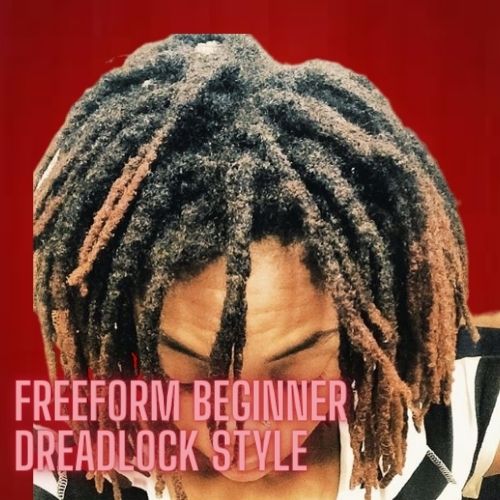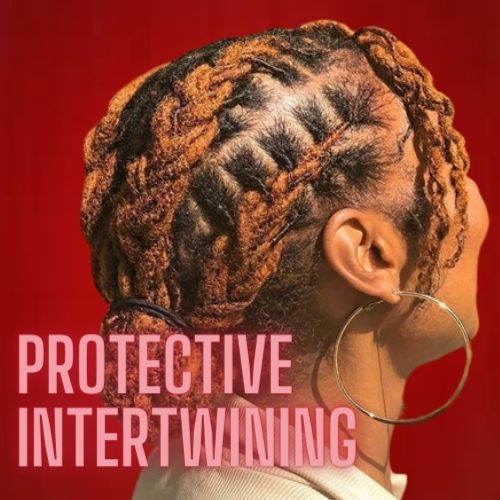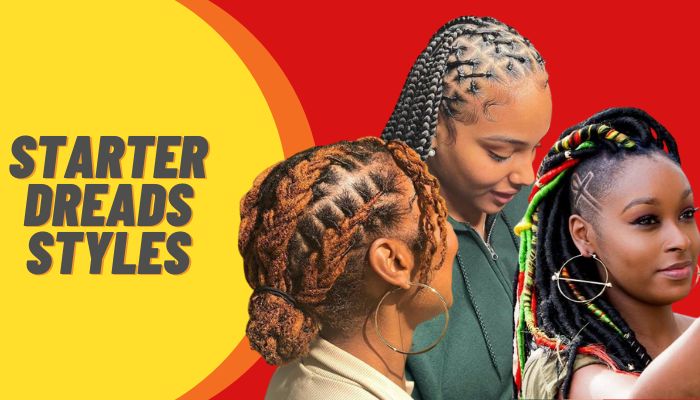The great thing about dreadlocks is that you can play around with whatever look you desire, depending on the length of your hair. Your short hair allows you to be more playful as you experiment with your style and figure out what look fits you.
Let’s look at the best starter dread styles for 2022 to get you started!
Best Starter Dreads Styles list
- Criss-cross dreadlocks
- Finger coils
- Freeform beginner dreadlock style
- Dyed and coloured short dreadlocks
- Protective intertwining short dreadlock style
- Backcombed short dreadlocks
- Starter coils dreadlock
- Pixie dreadlocks on short hair
- Comb coils
Best Starter Dreads Styles Reviewed
1. Criss-cross dreadlocks

Despite its simplicity, criss-cross dreadlocks are a style that brings out your desired appeal. You can wear criss-cross dreadlocks at work, or for that sales pitch if you want to appear more professional.
You need to take three locks from the front of your hair and lay them in a criss-cross pattern towards the back of your head.
A six-inch or longer starter lock is ideal for this dread style. It gives you more breathing room and makes you look more feminine when you cross your starter locks. Children, women, and men can all wear this style.
Pros
- Long-lasting
- Convenience
- Gives a breathing room.
- For a professional look.
Cons
- It may be painful for a few days.
2. Finger coils

To set the coil, you’ll section the hair into sections, twist them into spiral coils, and pin them while they dry.
You will use these coils to create your new dreadlocks. Finger coils form locks after about 6 months to a year.
As the hair twists around itself into coils, this method is best for kinky, coily hair. The method works best on short or medium-length hair – long hair can be dreaded, but with patience, it can be done.
To finger coil your dreads:
- Section your hair using a rat tail comb into as many square sections as you’d like. Each section will form a loc. The thicker the sections, the larger the dreadlock will be. For smaller locks, take smaller sections.
- Use your spray bottle to mist the first section until it’s damp.
- Apply a small amount of coconut oil (or other oil of your choice) to the roots, pulling it down to the tips of the hair in this section.
- Start twisting the hair in one direction until it forms a coil, then pull on the section and let it snap back upward.
- Clip the coil in place at the scalp and repeat all steps on the next section until complete.
- Let your hair dry completely and remove the clips from all sections.
You’ll leave these finger coils in place to allow them to form into dreadlocks.
Pros
- Easier to DIY
- Styling is less painful.
- Ideal for both genders.
Cons
- It May is not long-lasting for some
3. Freeform beginner dreadlock style

If you don’t want anything fancy, you can settle for the freeform look. All you need to do is just let your hair grow and twist itself after a few months.
The freeform style is quite relaxed and does not necessitate retwisting or interlocking of fresh growth. This means you won’t have to bother about retwisting your hair, products, or anything else as you advance through your dreadlocks journey. Allow it to grow.
Pros
- Less demanding
- Require less upkeep
- Freedom to style on its own
Cons
- Can grow bigger than expected.
- May not be easier to style when mature.
4. Dyed and coloured short dreadlocks

You can dye your dreadlocks while they are short, and you don’t have to wait for them to grow to a considerable length. And you can use the same products you use for ordinary hair on your locks.
You can experiment with different colours to see which one suits your skin tone or dreads. Commonly, people with dreads dye only the edges or ends of their dreads fashion-wise or to protect their scalp.
The common dye colour used is blonde.
Pros
- Give a new look
- Easier to DIY
- The dye can be changed.
Cons
- The dye may cause breakage.
5. Protective intertwining short dreadlock style

This interconnecting pattern has long been considered one of the best short dread styles for women. This is due to the ease with which it may be styled or DIYed. Furthermore, it is less invasive than retwisting your hair, which is what most individuals with dreadlocks want from their dreadlocks.
Pros
- Simple to style
- Not invasive
- Long-lasting
Cons
- May be painful for a few days.
6. Backcombed short dreadlocks

Backcombed hair is one of the most amazing natural short dreadlocks styles for both genders. The style helps hair to lock together within a few weeks, leaving the roots with a free-part finish.
You can choose to backcomb your locks halfway, on one side, or backcomb only the front so it can relax on the scalp.
However, if the tips of the hair don’t coil, a backcomb is the solution you need.
Pros
- Easier to style
- Pain-free
- Simple to wear
Cons
- Takes time to style.
7. Starter coils dreadlock

Begin your dreadlock journey with starter coils. It is one of the most popular natural short dreadlocks styles among women.
However, for this style to last and protect your scalp, you must twist your hair with the proper treatments. Furthermore, the style may vary depending on your hair texture, density, and hair care. Tightly coiled or kinky hair, rather than curly or loosely coiled hair, will look best with this style.
Pros
- Easy to style
- Perfect for coiled hair
- Long-lasting
Cons
- Not favourable for curly hair
8. Pixie dreadlocks on short hair

Pixie dreadlocks in short hairstyles are suitable for people with naturally curly hair, particularly ladies. The hair is incredibly short and coiled into springs that are placed in a clean and lovely pixie style. The best part is that it is appropriate for both professional and informal settings.
Pros
- Easy to rock.
- Best for a formal and casual look
- Easier to style
Cons
- May be painful
9. Locks with an undercut

Short hair is the best to experiment with, and if you are growing dreadlocks, there is no better time to do this than at the beginning.
Dreadlocks with an undercut are therefore the best option. Contact your loctician and barber and have them work on this masterpiece. Short dreadlocks complement the outfit perfectly.
Pros
- Give a masculine touch.
- Ideal for both genders.
Cons
- Unfavourable for formal settings.
10. Comb coils

Comb coils are one of the best beginner locks you can try. As sleek as they appear, they demand some attention in the newborn stage because they can be easily untwisted. It should also be left alone for a few weeks before the first wash.
If you’re doing your hair, slip a fine-tooth comb into a portion of hair close to your roots—as thick or thin as you like—and twist the comb around as you pull the comb toward the end of the section.
Pros
- Easy to DIY
- Gives a sleek look.
- Can be kept for long
Cons
- You need a few weeks before the first wash.
What are the types of dreadlocks?
Dreadlocks come in a variety of styles. Freeform, twists, rips, twists, and interconnecting dreads are the most frequent.
Freeform or natural dreadlocks are formed by just allowing the hair to lock up on its own.
Twists, which are made by twisting strands around each other, are often preferable for coarser, kinkier hair.
Rip and twists are made by twisting the dreaded hair, splitting the twists, and then re-twisting in the opposite way, resulting in knots and, eventually, dreads.
Consequently, when the end of the lock is dragged through the root to strengthen the new growth on the scalp, interlocking dreads are formed.
How to care for your starter dreads
1. Light products
When dreading your hair, light gels, oils, and shampoos are essential for promoting growth. Light clarifying shampoos, such as Taliah Waajid’s Stimulating Herbal Cleanser, or an apple cider vinegar rinse is ideal for shampooing.
To moisturise and keep your dreads looking neat without white residue and buildup, use light oils like almond or olive oil and light gels like aloe vera gel daily.
2. Wash Your Hair Every 2-3 Weeks
It is suggested that you wash your hair every two to three weeks. Even if you are just starting to lock your hair, it is vital to wash it with a clarifying shampoo. Water helps your hair kink and curl, and shampooing keeps your scalp clean and free of deposits like dandruff.
3. Wrap Your Hair before bed
There will be times when you will still need to wrap your hair to prevent damage, such as when you’re going to bed. Wrapping your hair helps to keep it in place and tidy.
And, if you’re gardening or working out, try to keep your hair wrapped to avoid getting it sweaty or dirty with debris.
A basic guide for growing dreadlocks with short hair.
1. Assess your initial hair length.
You can grow dreadlocks at any minimum hair length. The variety of ways you can begin developing dreadlocks, though, ultimately relies on the length of hair you have when you first start.
If at all possible, hold off on starting to twist and manipulate your hair into dreadlocks until it is at least three to six inches long.
2. Consider your hair texture.
Additionally, when growing dreadlocks, you must consider your hair texture. Typically, black hair is curly, wavy, kinky, and easily entangled in natural coils. You can work with your hair more effectively if it’s a bit longer.
3. Analyze the visual appearance.
Take into account aesthetic factors too. When you start developing dreadlocks with short hair, you won’t have lengthy dreadlocks for months. It may take a year for your dreadlocks to reach a reasonable length. Your first dreadlocks will be short, spiky, or thick hair knobs protruding from your scalp.
Do you want to wait for a few inches for your natural hair to grow before you lock it? Or you don’t mind? The choice is yours.
4. Consider the sacrifices.
You must also consider the time and grooming sacrifices that are required when beginning dreadlocks with short hair. Instead of transforming your current hair length into dreadlocks, you will grow and twist dreadlocks from the scalp.
Things to Consider Before Getting Dreads
1. Dreads Can Hurt
New dreadlocks are soft and flexible, whereas mature dreadlocks are rigid and tight. Sleeping with dreads can be uncomfortable or even painful, according to people with this hairdo.
2. You May Experience Frizz and Itching
If you have dreads, you will have frizz, especially at first. Some products can help you control frizz, but the nature of dreads makes it unavoidable. This must be understood immediately. Another common issue among deadheads is itching.
If you do not exfoliate your scalp regularly, you may experience flakes and itching. You can cure a dry scalp using moisturisers and oils but be warned that itching can occur.
3. They Take Time to Mature.
If you want nicely groomed, uniform dreads from the start, you’ll be disappointed. Dreads take time to grow and mat into locks. They may first appear awkwardly shaped, protrude at weird angles, or replicate the pattern of the braid or twist you’re using to begin them.
This is normal and expected, but you should be prepared.
4. You’ll Hear Everyone’s Opinion
Dreadlocks can elicit unfavourable reactions, so be prepared to get criticism from anyone who doesn’t like your locks. You’ll hear anything from rude remarks to well-intended questions about whether or not you wash them, why you chose dreads, and so on.
Knowing this ahead of time will allow you to respond to these situations with calm and preparedness.
5. They’re Not Meant to be Temporary.
Dreadlocks are a long-term hairstyle that should not be worn for an extended period. The knotting, tangling, and matting required to form mature locks takes time.
And once tied, those knots are securely fastened. It is tough and time-consuming to remove dreads, but it is feasible. Avoid dreads if you simply want to experiment with your hairstyle.
Frequently Asked Questions (FAQs)
How long does it take for beginner dreads to lock?
3-6 months. The starter, also known as the baby stage of the loc process, can last anywhere from three to six months, depending on your hair type and how fast it grows. There are several styles—such as braids, two-strand twists, comb coils, and palm rolls—that you can choose from to start your locks.
How do I stop my starter locks from unravelling?
A few ways to prevent some of the unravellings include, sleeping with a satin bonnet or loc sock, asking your loctician for suggestions, or being more gentle when you wash your hair. You will be in the “baby” stage for approximately 9 months. It will be shorter or longer depending on your hair type.
Can locks be undone?
Yes, dreadlocks can be combed out, especially ones that have been properly cared for during their life, including regular shampooing and conditioning. This is very important! If you decide to comb out your ‘locks, you must approach the process with a lot of patience.
When can I dye my starter locks?
Spring is the perfect season to change or freshen up your lock hair colour. You’ve been working on yourself and getting ready for summer. Now it is time to start shining! It gets warmer at this time of year, so it makes it much easier to keep your hair moisturized, which is essential when colouring your hair.
Do dreads smell?
Dreadlocks are essentially matted hair, which has the potential to trap odours quicker than loose hair, but this doesn’t mean that dreads smell bad or that they’re doomed to eventually smell bad. If you don’t know how to care for your dreads properly, you could end up with an offensive smell.
What’s Next…
Dreadlocks are a signature piece of art now transcending beyond Africa. Anyone all over the world can wear dreads as long as they decide to. Be warned, however, that despite its acceptance as popular culture, it still faces discrimination in some formal settings.
You can decide to have dreadlocks permanently or temporarily for a few years. The thing is, you need the patience to see the results you need. From the various styles and methods shared, you can choose which is better for you.
I wish you all the best in your dreadful journey.
Read Related Articles:
- Budding Locs: Everything you Need to Know!
- Starter Dreads: Everything You Need to Know!
- How Long Does it Take for Starter Locs to Lock
- Thick Dreads vs Thin Dreads: Which is Better?
- Hot Oil Treatment for Locs: The Ultimate Guide!
- 3 Strand Twist Dreads: The Ultimate how-to Guide!
- Dry Shampoo on Locs: All you Need to Know [+ Top Picks]
- Dreads Thinning at Crown: X Common Cause and Solutions
- How Many Dreads Should I Have? Locs Number + Size Chart
- How to Start Wicks With Rubber Bands: Step-by-Step Guide!
- Wicks Dreads: Everything You Need to Know about this Hairstyle!
- Hard Locs: X Common Mistakes & Maintenance Tips for Soft Locs
- How to Lock Dreads Faster With Sea Salt Spray + Other Alternatives
- Are Dreadlocks Dirty? Why Locs Look Dirty & How to Keep Yours Clean
- Dread Detox Recipe Options: How to Deep Cleanse Locs (ACV Rinse + Other Recipes)
